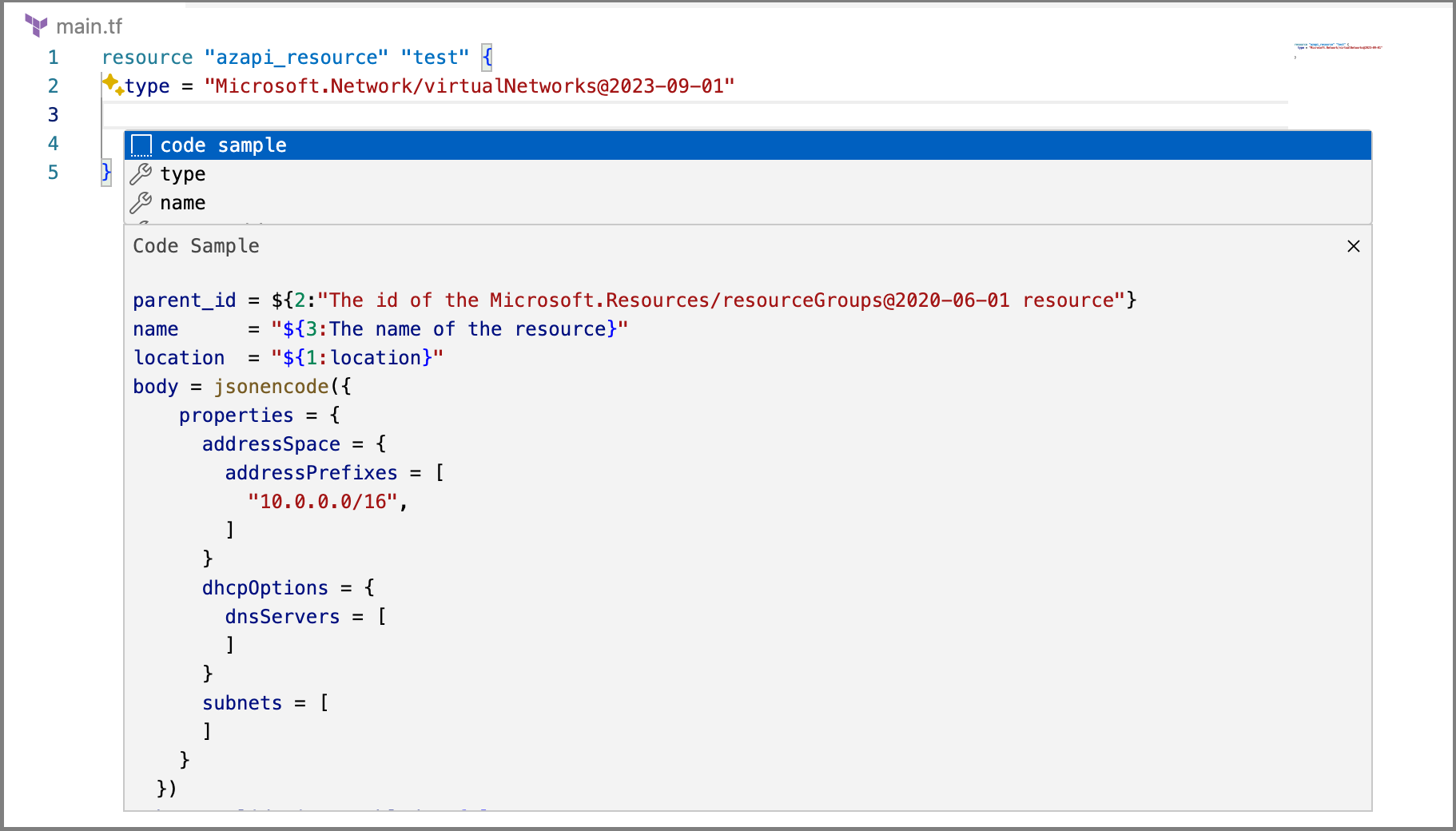Overview of the Terraform AzAPI provider
The AzAPI provider is a thin layer on top of the Azure ARM REST APIs. The AzAPI provider enables you to manage any Azure resource type using any API version. This provider complements the AzureRM provider by enabling the management of new Azure resources and properties (including private preview).
Resources
To allow you to manage all Azure resources and features without requiring updates, the AzAPI provider includes the following generic resources:
| Resource Name | Description |
|---|---|
| azapi_resource | Used to fully manage any Azure (control plane) resource (API) with full CRUD. Example Use Cases: New preview service New feature added to existing service Existing feature / service not currently covered |
| azapi_update_resource | Used to manage resources or parts of resources that don't have full CRUD Example Use Cases: Update new properties on an existing service Update pre-created child resource - such as DNS SOA record. |
Resource configuration examples
The following code snippet configures a resource that doesn't currently exist in the AzureRM provider:
resource "azapi_resource" "publicip" {
type = "Microsoft.Network/Customipprefixes@2021-03-01"
name = "exfullrange"
parent_id = azurerm_resource_group.example.id
location = "westus2"
body = jsonencode({
properties = {
cidr = "10.0.0.0/24"
signedMessage = "Sample Message for WAN"
}
})
}
The following code snippet configures a preview property for an existing resource from AzureRM:
resource "azapi_update_resource" "test" {
type = "Microsoft.ContainerRegistry/registries@2020-11-01-preview"
resource_id = azurerm_container_registry.acr.id
body = jsonencode({
properties = {
anonymousPullEnabled = var.bool_anonymous_pull
}
})
}
Authentication using the AzAPI provider
The AzAPI provider enables the same authentication methods as the AzureRM provider. For more information on authentication options, see Authenticate Terraform to Azure.
Benefits of using the AzAPI provider
The AzAPI provider features the following benefits:
- Supports all Azure services:
- Private preview services and features
- Public preview services and features
- All API versions
- Full Terraform state file fidelity
- Properties and values are saved to state
- No dependency on Swagger
- Common and consistent Azure authentication
Experience and lifecycle of the AzAPI provider
This section describes some tools to help you use the AzAPI provider.
VS Code extension and Language Server
The AzAPI VS Code extension provides a rich authoring experience with the following benefits:
- List all available resource types and API versions.

- Auto-completion of the allowed properties and values for any resource.

- Show hints when hovering over a property.

- Syntax validation

- Auto-completion with code samples.

AzAPI2AzureRM migration tool
The AzureRM provider provides the most integrated Terraform experience for managing Azure resources. Therefore, the recommended usage of the AzAPI and AzureRM providers is as follows:
- While the service or feature is in preview, use the AzAPI provider.
- once the service is officially released, use the AzureRM provider.
The AzAPI2AzureRM tool is designed to help migrate from the AzAPI provider to the AzureRM provider.
AzAPI2AzureRM is an open-source tool that automates the process of converting AzAPI resources to AzureRM resources.
AzAPI2AzureRM has two modes: plan and migrate:
- Plan displays the AzAPI resources that can be migrated.
- Migrate migrates the AzAPI resources to AzureRM resources in both the HCL files and the state.
AzAPI2AzureRM ensures after migration that your Terraform configuration and state are aligned with your actual state. You can validate the state has been updated by running terraform plan after completing the migration to see that nothing has changed.
Using the AzAPI provider
Install VS Code extension
Add the AzAPI provider to your Terraform configuration.
terraform { required_providers { azapi = { source = "Azure/azapi" } } } provider "azapi" { # More information on the authentication methods supported by # the AzureRM Provider can be found here: # https://registry.terraform.io/providers/hashicorp/azurerm/latest/docs # subscription_id = "..." # client_id = "..." # client_secret = "..." # tenant_id = "..." }Declare one or more AzAPI resources as shown in the following example code:
resource "azapi_resource" "example" { name = "example" parent_id = data.azurerm_machine_learning_workspace.existing.id type = "Microsoft.MachineLearningServices/workspaces/computes@2021-07-01" location = "eastus" body = jsonencode({ properties = { computeType = "ComputeInstance" disableLocalAuth = true properties = { vmSize = "STANDARD_NC6" } } }) }
Next steps
Feedback
Coming soon: Throughout 2024 we will be phasing out GitHub Issues as the feedback mechanism for content and replacing it with a new feedback system. For more information see: https://aka.ms/ContentUserFeedback.
Submit and view feedback for